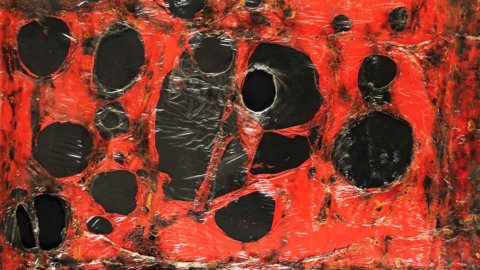After the significant success of the exhibition Alberto Burri: The Trauma of Painting in October 2015 at the Solomon R. Guggenheim in New York and the subsequent stop at the Kunstsammlung Nordrhein-Westfalen in Düsseldorf, the celebrations for the centenary of the birth of the great Italian artist will end with an extraordinary new exhibition appointment in Città di Castello, his birthplace.
A vast survey relating to the most significant trends in post-war contemporary art of the XNUMXth century, which it seems possible to combine with Burri's art both as thematically prior to it and as contemporary or subsequent, with identified dialectical aspects of more evident influence .
As stated by Richard Armstrong, Director of the Guggenheim Museum on the occasion of the opening of the retrospective Alberto Burri: The Trauma of Painting «the exhibition affirms Burri's position as one of the most innovative artists of the post-World War II period. Burri (…) created a new type of object, simultaneously pictorial and sculptural, which subsequently influenced artists associated with New Dada, Noveau Réalisme and Postminimalism…» and, one might add, with Italian Arte Povera.
To these considerations are added others, no less decisive for the linguistic invention resulting from his work. Burri is in fact the artist who, in the direct and almost exclusive use of the material, has obtained an unprecedented spatiality under the banner of a "control of the unexpected" and a masterly balance that has qualified its forms.
Starting from these considerations, in the new important exhibition appointment for autumn-winter 2016-2017, alongside a select nucleus of works by Burri – around 20 – from tars to moulds, from sacks to hunchbacks, from woods to combustions, from irons to plastics, from cretti to cellotex up to “black and gold”, it will be possible to admire works by Masters protagonists of the XNUMXth and XNUMXst centuries: Fautrier, Dubuffet, Pollock, Motherwell, Hartung, De Kooning, Wols, Calder, Marca-Relli, Scarpitta , Matta, Nicholson, Tàpies, Colla, Rauschenberg, Twombly, Johns, Fontana, Manzoni, Castellani, Uncini, Lo Savio, Klein, Rotella, Christo, Tinguely, Arman, César, Morris, Sonnier, Beuys, Kounellis, Calzolari, Pistoletto, Pascali, Nevelson, Piene, LeWitt, Scialoja, Mannucci, Leoncillo, Andre, Afro, Chamberlain, Capogrossi, Kiefer, Miró, Soulages and others.
Alongside the works of these artists, a photographic and documentary repertoire of the historic juncture between 1947 and 1989, including data on artistic currents, posters, leaflets, catalogues, publications, videos, films, biographical cards, theoretical productions and other significant illustrative materials , will wind along a separate path from the works themselves, facilitating the fruition of this particular historical cultural moment of art from the post-war period to the emblematic term of the end of the Cold War and the fall of the Berlin Wall.
On the occasion of this event, a catalog is planned which will collect essays and critical contributions by Pietro Bellasi, Paola Bonani, Mario Diacono, Thierry Dufr?ne, Aldo Iori, Petra Richter, Luigi Sansone, Chiara Sarteanesi, Francesco Tedeschi, Italo Tomassoni, Denis Zacharopulos , Adachiara Zevi, preceded by introductory speeches by Bruno Corà, curator of the exhibition and President of the Fondazione Palazzo Albizzini Burri Collection and by Richard Armstrong, Director of the Solomon R. Guggenheim Museum in New York.
The publication will be completed by images of the works on display and by the historical-bibliographic information concerning the artists.





